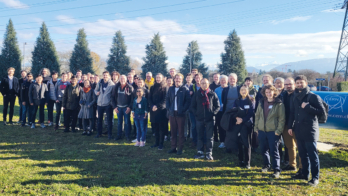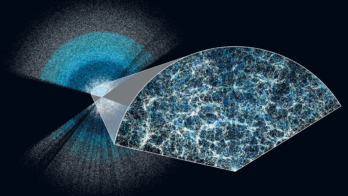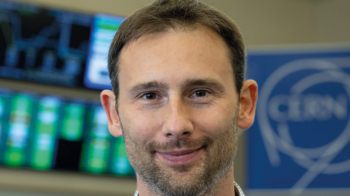Are black holes just a curiosity of nature or do they play a role in the formation and shaping of galaxies? The results of the most accomplished simulation to date show that the evolution of galaxies is influenced by the supermassive black holes at their centres.
Supercomputer simulations result in fascinating movies of the evolution of a portion of the universe over billions of years. They show how a uniform distribution of matter in the early universe progressively forms galaxies and clusters of galaxies – predominantly along a filamentary, sponge-like structure. This characteristic structure arises naturally from the mutual gravitational pull of matter making dense regions denser and voids emptier. However, a realistic simulation down to scales of single galaxies should include astrophysical processes that are related to the formation and evolution of stars and supermassive black holes.
The results of the first simulation to incorporate black-hole physics have now been published by Tiziana Di Matteo from the Carnegie Mellon University in Pittsburgh and collaborators. This gives the best picture to date of how the cosmos formed. Called BHCosmo, this simulation tracks 230 million hydrodynamic particles in a cube the size of about 100 million light-years. It used the 2000 processors of the Cray XT3 system at the Pittsburgh Supercomputing Center more than four weeks of run time.
The BHCosmo simulation starts from initial conditions corresponding to the standard ΛCDM model of cosmology and self-consistently incorporates dark-matter dynamics, radiative gas-cooling, star formation, as well as black hole growth and associated feedback processes. It is not well understood how supermassive black holes form, so Di Matteo and colleagues circumvented this problem by inserting a black hole of 105 solar masses at the centre of each dark-matter halo reaching a critical mass. These "seed" black holes can already form 300 million years after the Big Bang and their growth – by gas accretion and mergers with other black holes – depends very much on their environment. Strongly accreting black holes manifest themselves as quasars by emitting intense radiation that heats the surrounding gas. This heating in the BHCosmo simulation is found to be an important feedback process that expels the galaxy’s interstellar gas into inter-galactic space and in the mean time extinguishes the quasar activity. This mechanism helps to explain why most elliptical galaxies are left with a low gas content and can therefore no longer form new stars. Past quasar activity of the supermassive black holes in their centres would thus be responsible for their old and reddish stellar populations. The BHCosmo simulation also confirms the observed relationship between the mass of the black hole and the mass of stars in galaxies. This suggests that black holes regulate galaxy formation and growth, but how this happens is not yet understood.
This work shows how the formation and evolution of about a million galaxies can be simulated in a representative portion of the universe with relatively simple assumptions. The good match between the simulated and observed properties of galaxies allows the prediction of what sort of galaxies will be seen at very high redshift by next-generation telescopes.





